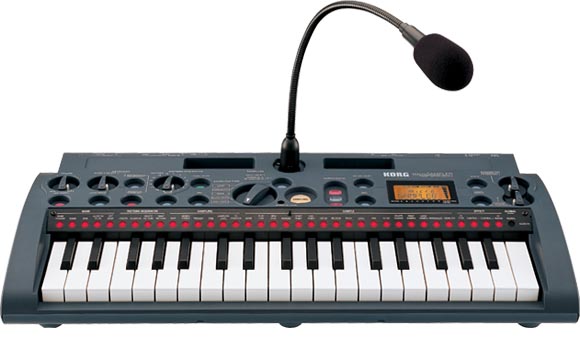It aims to do what for sampling what the insanely-popular microKORG keyboard has done for synths: that is, invade bedrooms and bands everywhere, and inspire a kind of love that other hardware finds elusive. But it also combines the micro-keyboard form factor and mic with everything that has made the KAOSS Pad series popular. It’s kind of a bundle of things about KORG that the masses love. So, perhaps that’s why the microSAMPLER leaked well before its introduction. I’m about the last to cover it, I think, so let’s see if I can get right to the point of what the microSAMPLER looks to be, and what it isn’t.
It’s a sampler for keyboard lovers. As the video notes, the world doesn’t need another sampler with pads. The keyboard is put to good use. It’s velocity-sensitive, though with mini keys to keep it compact. You can map different samples to different keys, slicing up your sample so that different lengths (from a 64th note to two measures). You can give keys different one-shot samples, for drum-style sounds. You can play looped samples. And you can map a single sample across the keyboard.
It’s built for capturing live. The mic has been torture-tested in lousy acoustic environments and onstage in the microKORG. It’s the design of the interface that makes this fun – and potentially worth considering over the software solutions that aim to do the same stuff. “Auto-Next” mode lets you tap in BPM from a source and automatically slice on the fly.
That isn’t an iPhone slot. The microSAMPLER has slots in which you can stick stuff, as noted by engadget. Yes, the photos and videos show iPhones and iPods, but they aren’t a dock, and you can put something more interesting in there – like a Game Boy or a PSP running LGPT. Rich Formidoni, the specialist you see in the video, tells me he’s tempted to use them for pretzels or mints. Heck yes. You can even sample the crunching sound. And I have just two words: aftermarket cupholder. (Coming soon to the CDM Store?)
You can resample and add effects. Resampling lets you “bounce” samples with effects or grab your playing to produce new samples. And the effects are borrowed from the KAOSS series, including tasty and distinctive-sounding ring modulator and grain shifter effects.
Loops and patterns. You can overdub pattern recordings into a pattern sequencer, switch between patterns, and take advantage of a loop recording feature derived from the KAOSSILATOR.
It’s really, totally ugly. I mean that as a compliment. Like somewhere deep in the Korg product design archives, the case design for the microSAMPLER has been lurking in a pile of schematic drawings from 1986. Not ugly in the bizarre way, like when KORG unveiled a camouflage version of the microKORG (handy for use in a duck blind). Ugly in a cool way, as if we’ve always had microSAMPLERs. Is “timelessly dated” a phrase?
It’s lo-fi when you want it to be. You can sample at a full 48 kHz (though, oddly, not at 44.1), but you can also crank down to 12 or 6 kHz for retro sampling capabilities. Updated: there is a decimator, too. I didn’t see it in the specs, but the microSAMPLER in fact has a 24-bit to 4-bit decimator effect. You can resample that, so while you can’t natively sample at lower bitrates, you get the same result.
It weighs only 4 pounds, and connects to your computer via USB, with editor/librarian software for Windows and Mac and import of WAV/AIFF files.
It runs on batteries.
Sample memory: 8 banks, 39 samples per bank, 160 seconds maximum per sample, for a total of between 21 and 170 minutes of mono samples depending on your sampling rate. (Check the specs.) That seems just enough to sacrifice some of the flexibility of computers with the accessibility of hardware.
US$750 I believe is list price, so, given what we’ve seen from KORG products before, expect a street below that.

The KORG piece is not without competition. Roland has just unveiled an updated version of its popular SP-404, the SP-404SX. It’s really the opposite of this unit; it’s a conventional, compact rectangle with pads as controllers. (Actually, it’s too bad Roland doesn’t have an option for a gooseneck mic for the SP-404.) At the other end of the spectrum, Native Instruments and Tim Exile have their own software-style solution to how to sample creatively live, using Reaktor under the hood – which means you get some very different-sounding granular effects than what’s accomplished by the KORG DSP. That’s to say nothing of loop samplers in the recent versions of Logic and Live. And I’m personally intrigued to see other takes on how to put together live samplers. In fact, I don’t think you could really compare any of these methods – we’re lucky enough to have commercial and DIY solutions that provide a range of options. So mostly what I’d like to see, aside from looking at the hardware, is people doing interesting creative an artistic work with these capabilities. There’s certainly no excuse for boring performances. Sample on. (Now, I’d better go off and practice.)
Updated: how loop recording works. In fact, you can get LoopStation-style loops which loop at the length of the initial recording. But likely to be more ideal is the ability to match tempo on the fly. Here’s an explanation from product specialist Rich:
The length of a conventional sample won’t determine the system tempo… but when you’re using the Looper effect, which records like a Kaossilator, it will continue to loop the same amount of time you used to record.
It does work the other way around, though. Samples can be set to timestretch on the fly, on an individual basis, to fit whatever the tapped system tempo is.
I think that actually covers what most people want – even if it would be cool to set the primary tempo to the length of a loop.